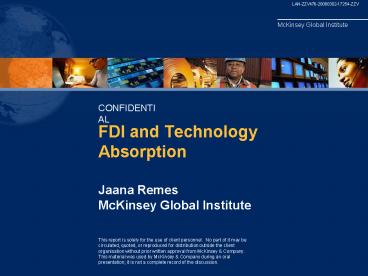FDI and Technology Absorption - PowerPoint PPT Presentation
1 / 14
Title:
FDI and Technology Absorption
Description:
FDI and Technology Absorption Jaana Remes McKinsey Global Institute This report is solely for the use of client personnel. No part of it may be circulated, quoted, or ... – PowerPoint PPT presentation
Number of Views:77
Avg rating:3.0/5.0
Title: FDI and Technology Absorption
1
FDI and Technology Absorption
CONFIDENTIAL
Jaana Remes McKinsey Global Institute
This report is solely for the use of client
personnel. No part of it may be circulated,
quoted, or reproduced for distribution outside
the client organisation without prior written
approval from McKinsey Company. This material
was used by McKinsey Company during an oral
presentation it is not a complete record of the
discussion.
2
MULTINATIONAL COMPANY INVESTMENT HAS
INCREASEDRAPIDLY IN THE PAST DECADE
Inflows Billions
- Main drivers
- Liberalization and privatization
- Decline in transport andcommunication cost
Based on estimates from OECD 2000 segmentation
of total FDI (developed and developing
countries) excludes resource seeking FDI
(e.g., for petroleum) Source OECD McKinsey
Global Institute WDI
3
A BROAD FACT BASE PROVIDES RANGE OF INSIGHTS
China
India
Mexico
Brazil
ü
ü
ü
ü
Auto
Consumer electronics
ü
ü
ü
ü
ü
ü
Food retail
ü
ü
Retail banking
üü
IT/BPO
Information technology/business process
offshoring (IT/BPO) completed individual case
studies for IT and BPO, thus bringing the total
studies completed to 14
4
MOST ECONOMIES CLEARLY BENEFIT FROM FOREIGN
INVESTMENT
Positiveor very positive impact in 13 out of 14
casesacross sectors
Verypositive
Positive
Overall FDI Impact
Neutral
Negative
Pure market-seeking
Tariff-jumping
Efficiency-seeking
Motive for entry
BPO IT Source McKinsey Global Institute
5
WE FOUND SOUND ECONOMIC FOUNDATION TO BE KEY,
WHILE INVESTMENT POLICIES WERE INEFFECTIVE AND
EVEN HARMFUL
Economic foundations
- Macroeconomic stability
- Competition
- Enforcement
- Infrastructure
Investment policies
- Incentives
- Import barriers
- TRIMs
TRIMs trade-related investment measures
6
FOUNDATIONS FOR ECONOMIC DEVELOPMENT ARE CRITICAL
Macroeconomic stability
- Precondition for MNC investment and FDI impact
Competitive environment
- Competition most powerful factor driving FDI
impact
Legal enforcement
- Informality reduced FDI impactand sector
performance
Infrastructure
- Important enabling condition for FDI impact
7
IN INDIAN AUTO SECTOR, LARGEST FDI IMPACT CAME
THROUGH INCREASED COMPETITION
Auto India
Labor productivity Equivalent cars per equivalent
employee indexed to 1992-93 (100)
Less productive than Maruti mainly due to lower
scale and utilization
Increased automation, innovations in OFT and
supplier-related initiatives
Productivity in 1992-93
Productivity in 1999-2000
Improve-ments at HM
Exit of PAL
Entry of new players
Improve-ments at Maruti
Indirect impact of FDI driven by competition
Direct impact of FDI
Actual cars and employment (not
adjusted) Source MGI McKinsey Global
Institute team analysis
8
IN MEXICAN FOOD RETAIL, WALMART ENTRY LED OTHERS
TO IMPROVE SUPPLY CHAIN EFFICIENCY
ROUGH ESTIMATES
Share of total sales distributed through centers
(2001 vs. 2005) Percent
Number of distribution centers in 2001
Wal-Mart
12
Between 1996-2001, WalMart labor productivity
grew by 2 annually, while it declined by 2
annually in the rest of the modern sector
Comercial Mexicana
4
60
58
Gigante
7
Soriana
6
80
Regional player in more developed Northern Mexico
Share of total sales distributed through
centers not updated Source Annual reports
9
IN BRAZILIAN FOOD RETAIL, PRODUCTIVITY INCREASES
BUT PROFITS EVAPORATE WHEN AN INFORMAL RETAILER
IS ACQUIRED BY A LARGE FORMAL RETAILER
Percent change
Despite a 32 increase in labor productivity . .
. Reals
. . . the net margin evaporates Percent
Pre
Post
Acquisition
Pre
Post
1,460
Number of employees
1,095
180
Gross sales R millions
144
Hours worked/year/ employee
2,328
2,328
163
Net sales R millions
125
Gross margin Percent
19
25
Gross margin per employee hour Note 1) See
next page for more detail on causes for observed
changes. 2) Margins based on net sales
Source ABRAS PNAD store visits interviews
McKinsey
10
INVESTMENT POLICIES HAVE NEGATIVE
AND UNINTENDED CONSEQUENCES
Incentives
- Fiscal and administrative cost
- Reduced productivity
- Race-to-the-bottom dynamics
Import barriers
- Limited competition
- Protection of low productivity players
TRIMS
- Protection of low productivity players
- Limited flexibility to compete
11
INCENTIVES CONTRIBUTED TO CAPACITY BUILD-UP IN
BRAZILSAUTO SECTOR
Collectively, the industry built more than double
what would have been expected under long-term
trends
1995 capacity
Investments based on long-term growth trends
2001 capacity
Additional investments, due to great expectations
for future growth
Further investments, due to incentives,
Sweetners, and the race to grow
Source McKinsey Global Institute
12
HIGH TARIFFS LIMIT COMPETITION AND INCREASE
PRICES IN INDIAS CONSUMER ELECTRONICS SECTOR
Average tariff/effective rate of protection on
final goods Percent
TV example Color TV price breakdown Index,
international best practice 100
Includes raw material, conversion costs and margin
130
Mobile phones
The protection offered by import duties on
domestic players finds to mask inefficiency
PCs
9-12
8-13
Refriger-ators
8-10
Interna-tionalbest practiceprice
Import duty on finishedgood
Import duty on raw material
Highermargin
Inefficiencyin the process
Retailprice
TVs
Source McKinsey CII report
13
WE FOUND SOUND ECONOMIC FOUNDATION TO BE KEY,
WHILE INVESTMENT POLICIES WERE INEFFECTIVE AND
EVEN HARMFUL
Economic foundations
- Macroeconomic stability
- Competition
- Enforcement
- Infrastructure
Investment policies
- Incentives
- Import barriers
- TRIMs
TRIMs trade-related investment measures
14
www.mckinsey.com/mgi































